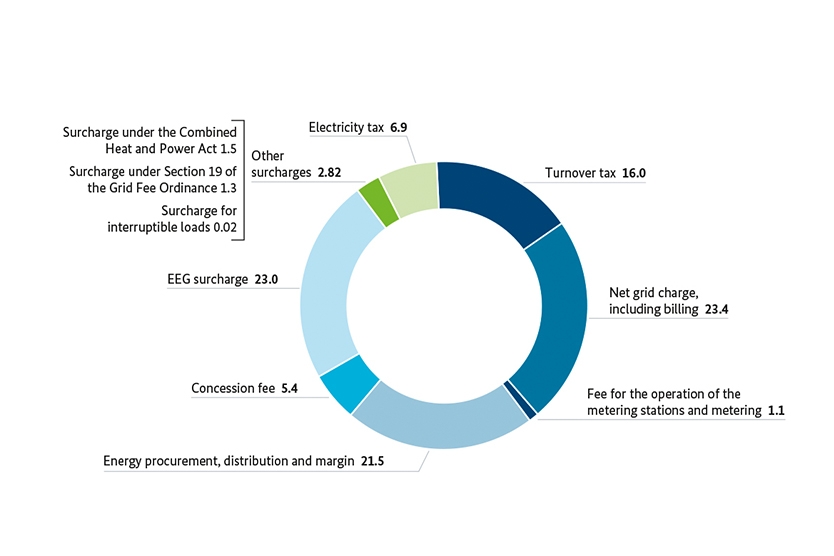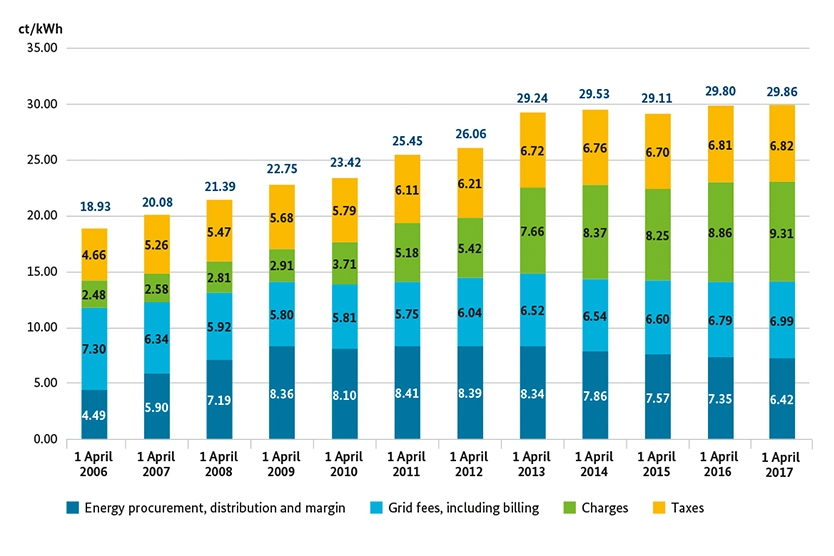Anyone receiving deliveries of electricity pays a certain price for it. The electricity price for residential customers consists of three main components:
- the price of the acquisition and sale of the electricity,
- the fees for using the electricity grid,
- and the state-imposed components of the price, such as taxes and the EEG surcharge.
The first price component is formed by competition between the electricity providers – it can therefore vary from one provider to another. The electricity consumers can in many cases save money by exercising care in their choice of electricity supply contract and checking whether it is worth switching provider or tariff.
In contrast, the electricity provider cannot influence the other components of the electricity price. This is because they are prescribed by legislation and government regulations.
According to the 2018 monitoring report compiled by the Bundesnetzagentur and the Bundeskartellamt (in German), roughly half of the electricity price results from the state-imposed price components. In 2018, they accounted for around 54%. The competition-based price component and the grid fees (including metering and billing costs) accounted for 22% and around 24% respectively.
What does this mean in practice? In 2018, residential customers with an annual electricity consumption of between 2,500 kWh and 5,000 kWh paid a total average electricity price of 29.88 cents/kilowatt-hour (kWh). Of this figure, the acquisition and sale of the electricity accounted for 6.70 cents/kWh (infographic (PDF, 306KB)).
It is important to compare the final prices charged by electricity providers. By switching providers, consumers can often save a lot of money. In 2018, the average electricity price paid by consumers consuming between 2,500 and 5,000 kWh a year under the basic contract with the standard local utility was 31.47 cents/kWh, whilst the average price paid by consumers under a different contract with the standard local utility was 29.63 cents/kWh, and by consumers buying electricity from a different provider was 28.80 cents/kWh. Even if less than one third of all residential customers now receive electricity from their standard local utility under a basic contract, residential customers should still make more use of their chance to switch provider (in German).
Grid fees vary across the country, because they depend on the costs in the specific grid area and the electricity consumption in that area. Regional disparities in transmission system fees are being phased out in the period up to 2023 by the Act on the Modernisation of the Grid Fee Structure (NEMoG) and an ordinance based on it. Further information can be found here. In 2018, according to the Monitoring Report compiled by the Bundesnetzagentur and the Bundeskartellamt (in German), the nationwide average was 7.19 cents/kWh including metering and billing costs (infographic (PDF, 255 KB)).
Until the end of 2018, the grid costs of the transmission system operators also included the offshore connection costs. Since 2019, these connection costs have been funded via the offshore levy (see below), not via the transmission system fees.

